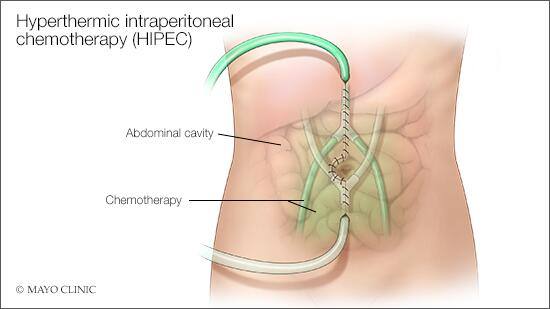-
Mayo Clinic Q&A podcast: Hot chemotherapy for late-stage cancers

Hyperthermic intraperitoneal chemotherapy (HIPEC) delivers chemotherapy directly into the abdominal cavity. It is used in conjunction with cancer surgery for people with advanced cancer that has spread inside the abdomen. “Hyperthermic” means warm or hot. “Intraperitoneal” means inside the abdominal cavity, which is encased in a sac called the peritoneum.
HIPEC uses high-dose chemotherapy to kill microscopic cancer cells inside the abdominal cavity. The HIPEC procedure is performed immediately after a surgeon has removed all visible cancer in the abdomen. HIPEC is well studied in several types of cancer and being explored as a potential treatment in others.
"So really any cancer that's just localized in the abdomen on the surface of the peritoneum could be a candidate," explains Dr. Travis Grotz, a Mayo Clinic surgical oncologist. "We know for sure, based on studies and data that HIPEC works well for cancers of the colon, cancers of the appendix, cancer to the ovaries, cancer of the stomach, and there's even a cancer of the lining of the peritoneum, called mesothelioma. So those would be the cancers I think that are well studied and well accepted. Then, there are more rare tumors that we have less data for, such as cancer to the pancreas or gallbladder or small intestine, that we don't know yet if that's the right treatment."
The specific type of chemotherapy used for HIPEC varies depending on the type of cancer being treated. The abdominal cavity is bathed with hot chemotherapy to kill any microscopic cancer cells that might still be present. Heating the chemotherapy enhances its effectiveness because, when it’s hot, chemotherapy penetrates the tissue more deeply, increasing the number of cancer cells it can reach.
On this Mayo Clinic Q&A podcast, Dr. Grotz explains what HIPEC is, how it is performed, and the risks and benefits of the treatment.
Related Articles:
- "New therapies bring hope for ovarian cancer."
- "Alternative chemotherapy offers hope for late-stage cancers."
- "Aggressive treatment turns tide in fighting colon cancer."
Watch: Dr. Grotz discusses HIPEC.
For the safety of its patients, staff and visitors, Mayo Clinic has strict masking policies in place. Anyone shown without a mask was either recorded prior to COVID-19 or recorded in a nonpatient care area where social distancing and other safety protocols were followed.







